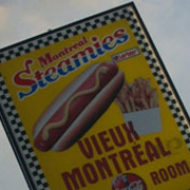Yesterday Carrie and I were sworn in as Canadian citizens. Our ceremony took about two hours. First, all 40-odd immigrants (from 25 countries) had to have their IDs checked, and get one last set of questions as to whether we’d been in trouble with the law or immigration since we submitted our forms. We also signed a form with the oath of citizenship on it, which meant (as with marriage certificates and weddings) that we were probably legal citizens at that point even though we hadn’t yet gone through the ceremony.* Then we were all called back into the room. A clerk explained the ceremony (in both English and French), and then a judge came in and spoke to us, mostly in French. She said all the things you’d expect her to say at a citizenship ceremony — it’s our big day, it’s an accomplishment, it’s a responsibility, we should explore Canada, fulfill our dreams, etc. But a couple things stood out.
Her speech had a section that was especially addressed to women. She talked about equality of opportunity for women as one of the defining aspects of Canada. She spoke about being able to be a woman judge. On one level, to the highly educated crowd I run with, this can sound hokey, or even problematic given the way “women’s rights” has been used as a lever in some Islamophobic talk. But on another level it rang true for me as something that distinguishes Canada. Can you imagine a U.S. citizenship judge instructing immigrants on women’s equal rights? And I have to say there was plenty of male entitlement (and not just male privilege) on display in France and Germany when I visited. Sure, it’s still a patriarchy here too, but the sentiment was meaningful given the occasion, and I can think of lots of occasions where there is a greater presumption of equality here than in other places.
Beyond the rights and responsibilities talk, she actually thanked us for becoming citizens. I’ve never seen or heard of an official of a country expressing gratitude to immigrants before. Maybe that’s common, but I found it notable. Also, amazingly, you actually get a decent free gift (not counting the Maple Leaf pin and flag).
After the speech, we had our names called to come up and collect our citizenship certificates and shake hands with the judge.
Then, we recited the oath of citizenship in both languages, and sang the national anthem, also in both languages. Right beforehand, the clerk spoke and said the second strangest thing I heard yesterday**: that he needs to see us saying the oath in order for us to be citizens, and that if he doesn’t see it, they might cancel our citizenship. Besides being utterly bizarre and probably unenforceable (they weren’t looking up photos as we were reciting the oath), it also suggests that they’re playing on people’s experiences in more authoritarian states. Then again, maybe with iris scanning, this will be our future as well. Or maybe not.
People were very happy, many pictures were taken, and yes, I got butterflies right before my name was called to go get my certificate. Afterwards, we went and had coffee at the Queen Elizabeth, with our friend Darin, who had joined us for the event.
Up next: my citizenship FAQ
—-
* All the interviews, documentation and medical checks happen for permanent residency. For citizenship, they count the days you’re physically on Canadian soil (very 19th century, but with an online “residence calculator”), and then you take a multiple-choice exam, which is really also a literacy test in French and English, and given the multiple choice works, also a test of a certain type of Western-style bureaucratic reason.
** The strangest thing was a pictographic sign on the inside of the bathroom stall doors instructing people to throw used toilet paper in the toilet, not on the floor. They must have had problems.




